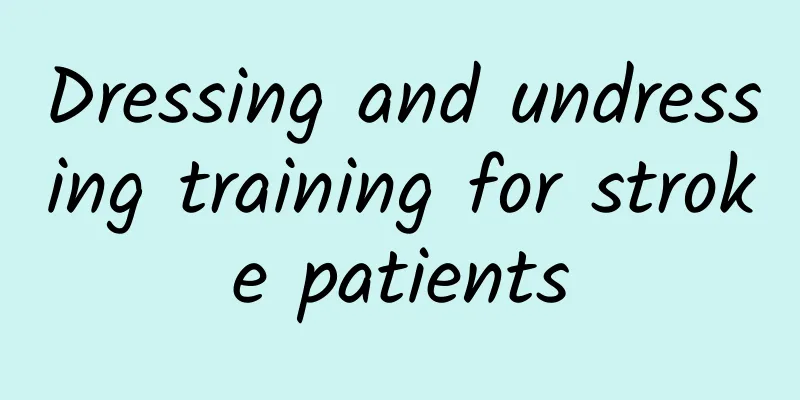Dressing and undressing training for stroke patients

|
Many hemiplegic patients can complete the dressing and undressing movements with guidance, training and partial assistance, using their remaining abilities. This is of great significance for patients to regain self-confidence, complete self-care, and reduce the burden on their families and society. Clothing: Tops: soft, loose-fitting pullovers, button-front cardigans. Bottoms: loose-fitting sweatpants. Shoes: loose-fitting elastic flat shoes without laces; sturdy, soft cotton socks. Dressing and undressing method: Patients should take a seat and bring their own clothes, shoes and socks as required. Put the clothes, pants, shoes and socks on the chair and move the chair to the healthy side for easy access. (1) How to put on and take off tops: Pullover: After the patient sits firmly, place the back of the shirt on the patient's legs, fold the back hem upward about 15 cm, put the affected arm on the other hem, use the healthy hand to hold the back hem to the cuff in turn into a cylinder, put it on the forearm of the affected upper limb, put the healthy upper limb into the other sleeve, extend the healthy hand to pull the sleeve of the affected upper limb, pull it up to the shoulder joint as much as possible, use the healthy hand to hold the back hem to the collar in turn, put it on the head in a cylinder, let the head pass through the collar, pull down the front hem, and then pull down the back hem to tidy up the top. When taking off clothes, take off the healthy sleeve first, then the collar, and finally the affected sleeve. Front cardigan: Place the affected upper limb on both legs, hold the affected front placket to the cuff in your hand to make it into a tube, put it on the forearm of the affected upper limb, pull up the shoulder of the affected sleeve to the shoulder joint, put it on the healthy upper limb, button it up and tidy up the top. When taking off the clothes, unbutton and take off the healthy sleeve first and then the affected sleeve. (2) How to put on and take off the bottoms: The patient can sit on the bedside or on a chair, cross the affected lower limb over the healthy lower limb, put the affected hand on the thigh of the same lower limb, and hold the front waistband of the pants with the other hand. Put the pants leg of the affected lower limb on the affected lower limb, put down the affected lower limb, put on the healthy lower limb, and the patient can stand up with the help of the bed, or lie on his back on the bed, pull the pants waist to the waist, and adjust the bottoms. When taking off the bottoms, the patient can lie on his back on the bed or stand on the bedside, pull the pants waist to above the knee joint, sit firmly, take off the healthy trouser leg, and then take off the affected trouser leg. (3) How to put on and take off shoes and socks: Place the affected leg disc on the other leg, place the affected hand on the ipsilateral leg, and use the healthy hand to put on the shoes and socks of the affected leg first, then put down the affected leg, and put on the shoes and socks of the healthy leg. When taking off shoes and socks, place the affected leg disc on the healthy leg, take off the shoes and socks of the affected leg first, put down the affected leg, and then take off the shoes and socks of the healthy leg. |
<<: These bad living habits are harming our eyes!
>>: What are the benefits of eating sushi? The correct way to eat sushi
Recommend
Is it good to frequently cast nets in lobster ponds? When is the best time to cast nets?
Crayfish farming is also a type of aquaculture th...
What are the benefits and functions of cherry tomatoes? How to wash cherry tomatoes
With the improvement of living standards, compute...
What to do if vaginal itching occurs after menstruation?
As women continue to grow, many of them will enco...
Why do vegetables that are kept fresh in the refrigerator quickly grow mold? Why do vegetables that are kept fresh in the refrigerator become moldy?
We all know that the temperature of the refrigera...
What to do if a pregnant woman is positive for Chlamydia
A positive Chlamydia test indicates that the body...
What to eat when taking the high-speed train for eight hours? Do students need to pick up their high-speed train tickets?
In the information age, people are sharing and so...
Vulva itching with many small particles
Some women inadvertently find that there are many...
The best time to correct malposition of the fetus
I believe everyone is familiar with the symptoms ...
Is there any impact if the baby is still breastfeeding and then becomes pregnant? Is there any impact if the baby is still breastfeeding and then becomes pregnant?
We all know that women will breastfeed after givi...
There is a small suppuration in the cesarean section incision
Caesarean section is a surgical procedure that as...
When will the anime "Heaven Official's Blessing" be released? Where can I watch the anime "Heaven Official's Blessing"?
Tian Guan Ci Fu is written by Mo Xiang Tong Xiu, ...
Can I have a painless abortion at 45 days of pregnancy?
Under normal circumstances, if a woman is sure th...
Why can't you wear a breathing valve mask on an airplane (the exhalation valve is a one-way valve)
...
Can pregnant women eat glutinous rice balls made with fermented rice wine?
Pregnant women are not allowed to eat fermented g...
Late pregnancy recipes
When women reach the late stage of pregnancy, the...







![[Anatomist who knows sports] How dare you exercise without stretching?](/upload/images/67f19520a1b6c.webp)

